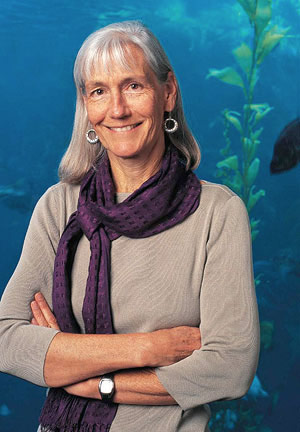
Spring 2005: 40 Years
r. r. jones
Julie Packard
Executive Director, Monterey Bay Aquarium
B.A. Biology, Crown College, 1974; M.A. Biology, 1978
The Monterey Bay Aquarium, which Julie Packard helped found and has led as executive director since it opened 20 years ago, is among the world’s most popular attractions. A recent national survey ranked it the best aquarium and one of the top family destinations of any kind, ahead of Disneyland and the San Diego Zoo.
But the aquarium is not just about family fun and entertainment—it aims to educate and inspire people to care about the oceans and help protect them. And with nearly 2 million visitors a year, the aquarium reaches a lot of people.
“We provide an opportunity for people to connect with ocean wildlife and establish a sense of caring for it,” says Packard, an eloquent and passionate advocate of ocean conservation.
In 1998, Packard was awarded the Audubon Medal for Excellence in Environmental Protection, and in 2004 she received the Ted Danson Ocean Hero Award from the conservation group Oceana. She also served on the Pew Oceans Commission, which issued an influential report on ocean policy in 2003.
The Pew Oceans Commission, in parallel with the U.S. Commission on Ocean Policy, undertook the first comprehensive review of national ocean policy in 30 years. These two independent efforts reached essentially the same conclusions: “Our oceans are in trouble, and the federal regulations we have now are not working to protect marine ecosystems,” Packard says.
Packard’s interest in science and nature started early. Her father, David Packard, cofounder of the Hewlett-Packard Company, was both a scientist and an avid outdoorsman. “I grew up with a very strong sense of connection to the environment,” Packard says.
Her passion for marine science, in particular, was kindled by a class in intertidal biology she took in her sophomore year at UC Santa Cruz. The class brought students out to the tidepools and introduced them to field research; it also introduced Packard to biologist William Doyle, founding director of UCSC’s Institute of Marine Sciences. She conducted research with Doyle both as an undergraduate and as a graduate student at UCSC, studying the ecology of marine algae.
Packard has made sure that the aquarium’s programs and exhibits are always firmly grounded in science. In addition, as concern about human impacts on the marine environment has escalated, the aquarium’s mission has evolved to become more explicitly focused on ocean conser- vation and advocacy.
Packard says she has been pleased to see marine scientists at UCSC and other institutions focusing more of their research on questions that relate to conservation issues. “Many UCSC scientists are working at the forefront of where I believe science needs to go, which is interdisciplinary approaches that are linked to real-world environmental problems,” she says.
She also says that getting undergraduates involved in research is essential for training the next generation of environmental scientists.
“There’s just no match for that kind of experience to get students engaged with the subject matter and fired up about exploring the natural world,” Packard says. “The opportunity for undergraduate research and the focus on undergraduate education is a real strength of UCSC.”
—Tim Stephens
---
PDF Version
|





